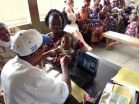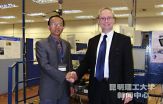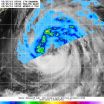(Press-News.org) CORVALLIS, Ore. – A new Oregon State University study of children with autism found that they are more sedentary than their typically-developing peers, averaging 50 minutes less a day of moderate physical activity and 70 minutes more each day sitting.
The small study of 29 children, some with autism and some without, showed that children with autism perform as well as their typical peers on fitness assessments such as body mass index, aerobic fitness levels and flexibility. The results warrant expanding the study to a larger group of children, said Megan MacDonald, an assistant professor in OSU's College of Public Health and Human Sciences.
"These kids, compared to their peers, are similarly fit," MacDonald said. "That's really exciting, because it means those underlying fitness abilities are there."
The findings were published this month in the journal "Autism Research and Treatment." Co-authors are Kiley Tyler, a doctoral student at OSU, and Kristi Menear of the University of Alabama at Birmingham. The study was funded in part by the U.S. Department of Education with additional support from OSU.
For the study, researchers tested the fitness and physical activity levels of 17 children with autism and 12 children without autism. The fitness assessments, conducted in the Movement Studies in Disability Lab at OSU, included a 20-meter, multi-stage shuttle run to measure aerobic fitness; a sit-and-reach test to measure flexibility and a strength test to measure handgrip strength; as well as height, weight and body mass index measurements.
The fitness tests were selected in part because they are commonly used in schools, MacDonald said. Children in the study also wore accelerometers for a week to measure their movement, and parents filled out supplemental forms to report other important information.
Even though they were more sedentary, the children with autism lagged behind their peers on only one fitness measure, the strength test. The results were surprising but also encouraging because they show that children with autism are essentially on par with their peers when it comes to physical fitness activities, MacDonald said.
"That's really important for parents and teachers to understand, because it opens the door for them to participate in so many activities," she said.
More research is needed to determine why children with autism tend to be more sedentary, MacDonald said. It may be that children with autism have fewer opportunities to participate in organized sports or physical education activities, but if that is the case, it needs to change, she said.
"They can do it. Those abilities are there," she said. "We need to work with them to give them opportunities."
MacDonald encourages parents to make physical activity such as a daily walk or trip to the park part of the family's routine. She's also an advocate for adaptive physical education programs, which are school-based programs designed around a child's abilities and needs. Some communities also offer physical fitness programs such as soccer clubs that are inclusive for children with autism or other disabilities, she said.
"Physical fitness and physical activity are so important for living a healthy life, and we learn those behaviors as children," MacDonald said. "Anything we can do to help encourage children with autism to be more active is beneficial."
INFORMATION: END
Children with autism are more sedentary than their peers, new OSU study shows
2014-09-26
ELSE PRESS RELEASES FROM THIS DATE:
Poor fish harvests more frequent now off California coast
2014-09-26
As a child in southern California, Ryan Rykaczewski spent a fair amount of time on his grandfather's boat, fishing with him off the Pacific coast near Los Angeles. At the time, he didn't think there was much rhyme or reason to their luck on the water.
"Sometimes we'd catch a lot of fish and sometimes we didn't," he says. "I just thought it was chaotic, that we could never understand what was going on."
But education changed his mind. Now an oceanographer and assistant professor at the University of South Carolina, he's working to understand the many factors that determine ...
Scanning babies' fingerprints could save lives
2014-09-26
Each year 2.5 million children die worldwide because they do not receive life-saving vaccinations at the appropriate time.
Anil Jain, Michigan State University professor, is developing a fingerprint-based recognition method to track vaccination schedules for infants and toddlers, which will increase immunization coverage and save lives.
To increase coverage, the vaccines must be recorded and tracked. The traditional tracking method is for parents to keep a paper document. But in developing countries, keeping track of a baby's vaccine schedule on paper is largely ineffective, ...
Decision analysis can help women make choices about breast reconstruction
2014-09-26
September 26, 2014 – Decision analysis techniques can help surgeons and patients evaluate alternatives for breast reconstruction—leading to a "good decision" that reflects the woman's preferences and values, according to an article in the October issue of Plastic and Reconstructive Surgery®, the official medical journal of the American Society of Plastic Surgeons (ASPS).
The special topic article by Mia K. Markey, PhD, and colleagues of The University of Texas at Austin and The University of Texas MD Anderson Cancer Center, Houston, introduces plastic surgeons to the ...
New tool assesses skill development in robotic microsurgery, reports Plastic and Reconstructive Surgery
2014-09-26
September 26, 2014 – A new standardized assessment provides a useful tool for tracking surgeons' progress as they develop the skills needed to perform robot-assisted microsurgery, reports a study in the October issue of Plastic and Reconstructive Surgery®, the official medical journal of the American Society of Plastic Surgeons (ASPS).
"The Structured Assessment of Robotic Microsurgical Skills (SARMS) is the first validated instrument for assessing robotic microsurgical skills," according to the report by ASPS Member Surgeon Dr Jesse C. Selber of the University of Texas ...
Disease without borders
2014-09-26
In a paper published this week online in Global Society, researchers with University of California, San Diego School of Medicine and the Urban Studies and Planning Program, also at UC San Diego, present a bioregional guide that merges place-based (territorial) city planning and ecosystem management along the United States-Mexico border as way to improve human and environmental health.
Issues like climate change, economic crisis, natural disasters and disease outbreaks do not stop at national borders, compelling public health officials, academics and researchers to think ...
Cardiology leaders call for global prevention of heart disease, stroke
2014-09-26
WASHINGTON (Sept. 29, 2014) — Heart disease and stroke contribute to 30 percent of global deaths, more than all infectious and parasitic diseases combined, and 11 cardiovascular organizations are calling for the United Nations to address prevention of heart disease and other non-communicable diseases.
In a statement published in the Journal of the American College of Cardiology and other cardiology journals, the World Heart Federation's Global Cardiovascular Disease Taskforce—which is comprised of cardiologists and health advocates from the World Heart Federation, African ...
Progress in materials science
2014-09-26
RESEARCHERS at the University of Huddersfield have collaborated with a colleague at a leading Chinese university to produce a detailed appraisal of a complex new welding technique that could be increasingly valuable to modern industry.
Professor Andrew Ball (pictured below) and his colleague Dr Fengshou Gu, of the University of Huddersfield's Centre for Efficiency and Performance Engineering, teamed up with Professor Xiaocong He of Kunming University of Science and Technology's (KUST) Innovative Manufacturing Research Centre in order to investigate the technique ...
Severe periodontitis: Sixth most prevalent health condition in the world
2014-09-26
Alexandria, Va., USA – The International and American Associations for Dental Research (IADR/AADR) have published a paper titled "Global Burden of Periodontitis: A Systematic Review and Meta-Regression." The manuscript, by lead researcher Wagner Marcenes (Queen Mary University of London, Institute of Dentistry, Barts and The London School) is published in the OnlineFirst portion of the IADR/AADR Journal of Dental Research (JDR).
The purpose of this study was to consolidate all epidemiological data about severe periodontitis and subsequently to generate internally consistent ...
Morphed images of Hollywood celebrities reveal how neurons make up your mind
2014-09-26
An international team of scientists, involving Professor Rodrigo Quian Quiroga, director of the Centre for Systems Neuroscience and Head of Bioengineering at the University of Leicester, has shown how individual neurons in the human brain react to ambiguous morphed faces.
For this, the researchers used images of celebrities, such as Angelina Jolie and Halle Berry, morphed together to create an ambiguous face which test subjects were asked to identify.
The study found that for the same ambiguous images, the neurons fired according to the subjective perception by the ...
NASA sees Tropical Storm Kammuri's spiral bands of soaking thunderstorms
2014-09-26
Tropical Storm Kammuri continues to strengthen on its north-northwestern track through the Northwestern Pacific Ocean and NASA's TRMM satellite identified a band of thunderstorms containing heavy rainfall northwest of the storm's center. Meanwhile NASA's Aqua satellite got a look at the entire storm and saw that those bands of storms circled the entire storm.
The Tropical Rainfall Measuring Mission or TRMM satellite flew over the northern half of Tropical Storm Kammuri on Sept. 26 at 1:44 a.m. EDT and the Precipitation Radar instrument saw a strong band of thunderstorms ...



